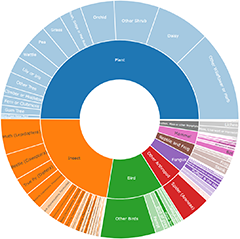Butterflies (Lepidoptera, Rhopalocera)
Butterflies, along with moths (which are not dealt with in this section), belong to the Order Lepidoptera. We have over 400 species of butterfly in Australia. Our local butterflies belong to five families: the Skippers (Hesperiidae), Blues (Lycaenidae), Nymphs (Nymphalidae), Swallowtails (Papillionidae), and the Whites and Yellows (Pieridae).
While there are a handful of butterfly species which can be observed on the wing at any month of the year, the butterfly season is generally from September through to April. Most species will fly for only a part of the season however. Butterflies prefer warm, sunny, calm weather, and it will be much easier to find butterflies in these conditions. Some species also prefer to fly at a certain time of the day. It is often easier to observe butterflies at high points in the landscape like hill summits, as the males of many species of butterfly will congregate at such points to set up breeding territories; this behaviour is called hilltopping. Another easy way to find butterflies is to locate flowering plants and watch what butterflies come to visit.
When taking photos of butterflies, it is most helpful to obtain images of both the upperside (dorsal) view of the wings, in addition to the underside (ventral) view of the wings. This makes the identification process much easier for some of the hard-to-identify species. If possible, including features of the butterfly’s surrounds for context can be helpful for determining the relative size of the butterfly. Bear in mind that as a butterfly ages, it can become quite tatty and faded, so that it may have chunks of a wing missing, or appear much paler than it otherwise appears in photos.
Butterflies are the adult stage of the life cycle (so it’s important to note that if you see a small butterfly, it is not going to grow into a larger one, it will stay the same size!). Adult butterflies are the life stage responsible for the reproduction and dispersal of the species; the females lay eggs singly or in clusters on or near the larval food plant; these eggs then hatch into larvae (caterpillars) which are the life stage responsible for eating and growing; these then form a pupa (chrysalis) where the larval stage transforms into the adult butterfly. Some species will overwinter as eggs, or as larvae, or as pupae. Some species are migratory and do not overwinter here at all, and some species are only occasional vagrants to our area.
Further reference on Australian Lepidoptera by one of our Moderators Don Herbison-Evans can be found on the following web pages:
Announcements
Hello NatureMaprsAs we move into the cooler months and sighting counts begin to wind down our team has been working tirelessly to ensure our platform’s usability and performance. All merch has been po...
Continue reading
Improvements to data import tool (coming soon)
NatureMapr welcomes Edgar McNamara
Platform wide attribute changes
New Feature: Moderator Quick Responses!
Discussion
Top contributors
- MatthewFrawley 1.4K
- JohnBundock 963
- RAllen 930
- RodDeb 707
- Christine 676
- AlisonMilton 584
- ConBoekel 437
- KMcCue 436
- LisaH 374
- HelenCross 366
Top moderators
- SuziBond 5.6K
- owenh 3.8K
- MatthewFrawley 2.6K
- MichaelMulvaney 679
- AlisonMilton 589
- MichaelBedingfield 278
- Liam.m 217
- DiBickers 197
- CharlesDove 124
- EwinP 80






